Links matter.
Links are still the MAJOR ranking factor for Google search. Links can get your site to rank, and your affiliate/commercial content to make you money.
Link juice (PageRank) from external backlinks can go directly to the target page, or reach it via internal links on a target website.
Which way is better?
Matt Diggity recently put the SkyScraper technique to a test. Does it really work as it’s often told? Is it an effective way to bring link equity to your key money pages so they rank highly in Google?
Here’s what Matt did (+ test summary).
He created a single-variable test website with only 2 pages. Page A (the stand-in for a skyscraper post) received 5 powerful PBN links, while page B was mostly orphaned and the only incoming link it had was an internal link from page A.
The goal was to see if any link juice will flow from page A to B, how much, and how long it’ll take to reflect in the SERPS.
His results were:
- Page B’s rankings improved, but it took nearly 2 months for that ranking change to happen;
- The main keyword had only a moderate jump, moving from position #39 to #29.
The test’s conclusion was that the Skyscraper technique is not ideal and that building links directly to money pages is key for rapid rankings in Google and sustained traffic growth.
But how do you build links to your money pages? Is it really possible?
Yes it is; and read below to learn how.
5 Ways to Build Links To Your Commercial Content
No, it’s not a typo.
There are at least 5 effective ways to build links to your commercial content.
More than enough to rank pretty much anything on the first page of Google.
Let’s start with…
#1- Interview Link Building
Once you develop even a little bit of clout in the industry, you’re going to get your inbox inundated with interview opportunities. Make sure you accept most of them, even if they come from low authority, or new websites.
Why?
It’s because interviews are an excellent way of building natural links to your money pages.
For example, see how Matthew Woodward in this interview freely links to his money pages using keyword-rich anchor text.

These links are followed (as shown by the Mozbar), natural, help him rank better, and are editorial in a sense that the interviewer host has allowed them to happen.
The con to this strategy is that there’s zero page-level relevance and only anchor text relevance passes through those links.
Again, from the same example you saw that Matt links to his Ahrefs, Semrush and SEO Powersuite guides; but his interview is not about Ahrefs, SEMrush or SEOPowersuite.
It’s about Matt.
#2- Expert Roundups
But also think strategically and see how you can give even more value by linking from your contribution to a post on your blog that supports your claims.
For example, recently I contributed to this roundup on the best SEO strategy.
I talked about how the best SEO strategy for this year and going forward is to:
- Start with technical SEO;
- Continue with excellent keyword research;
- Create awesome content;
- Do superb on-page SEO;
- Promote on social media;
- Build links;
- Etc
And I made sure to mention one (money) article on my site that saw clear improvement immediately after I implemented the change.

The pro to this strategy is that it’s very easy to get away with linking to your commercial content.
The con is that these links won’t be super relevant and also, your link might get stripped if you link with a keyword rich anchor text.
So use your best judgment when adding in links and understand that a generic-anchor-text link is much better than no link at all.
Pro tip: Use page level relevance to your advantage. Meaning, even if you don’t use your target keyword within the anchor text, have your target terms and phrases somewhere close to that link.
This will communicate relevance to Google and make your link stronger.
Here’s how I used this technique to my advantage with a backlink pointing to my site.
And even though the link has my desired anchor text, I believe the relevant words around the link make it even stronger.
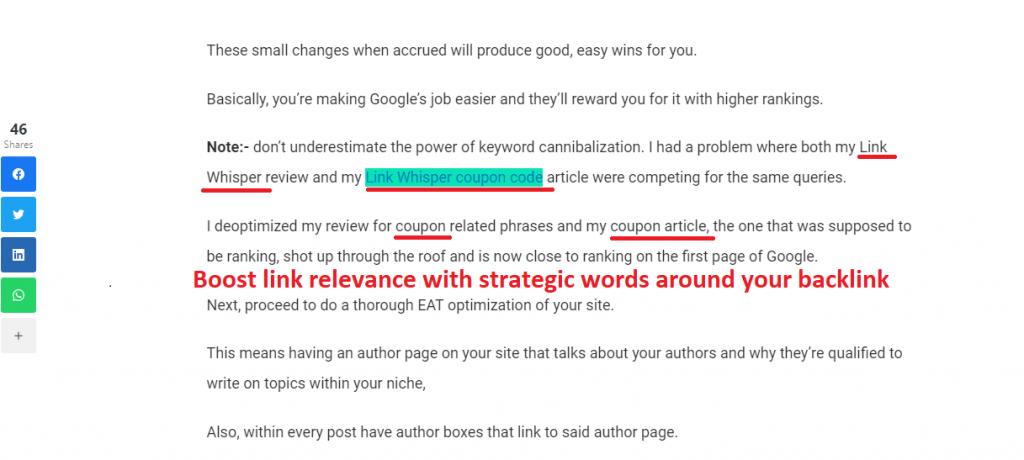
#3- Use the IKEA Effect in Link Building
What is the IKEA effect in link building?
It’s when you ask other bloggers to contribute to your money page so that once published they feel like it’s their content too.
Here’s how it works:
First, ask them to contribute to your page. Their addition should be within reason and easy for them, 100-300 words max.
And promise them a homepage link for their effort.
Second, add in their contributions to your post and per each blogger add a second link to one of their relevant money pages.
It is crucial that you add a second link and I’ll explain exactly why below.
Third, once your post is published, do email outreach.
Ask them to share your article with their followers on Twitter and Facebook; tell them about their additional link, the one they didn’t expect; and then ask them if they’ll be so kind to add a link to your roundup from a post on their site.
Note: you need to tell them exactly where they can add in your link. That way you make it easy for them as they don’t have to think about it.
But also, when suggesting a page you can pick one that’s most relevant to your roundup and has some links pointing to it. This helps with your page’s SEO even more.
(Pro tip: Use Screaming Frog to check internal links to the page).
Fourth, get your link placed, thank them and promise to return the favour in the future, and watch your rankings improve.
How about a solid example from my site?
About a month ago, I updated this page on my site by adding the contributions of 7 webmasters.
And after I’ve gone through the steps mentioned above I got 6 links out of 7. The seventh blogger also promised me a link but failed to deliver, and since it’s been over a month, I doubt he will.
6/7 is ~85 success rate, which is excellent.
The IKEA effect in link building works because it really does resemble the real life IKEA effect in that bloggers are proud of their contributions and willing to link to it.
Another important reason is reciprocity.
Remember the second step where I said you need to link to them the second time, and that link should go to their money page? That’s part of your strategy.
Because it’s a surprising link, and because you’ll link to one of their pages that can make them money, the blogger feels grateful and has a great urge to somehow return the favour.
The pro to this strategy is that links are nearly guaranteed. I got 6 links out of 7 bloggers or ~86% hit rate.
The (possible) con is that these backlinks will be reciprocal links which is not ideal for SEO.
However, reciprocal links in moderation are perfectly fine and this tactic should not be abused, but used sporadically on your key money pages i.e., kings of kings.
Note: in case you were wondering, I did see a significant rankings increase in the week after Google has crawled and indexed those 6 reciprocal links.
#4- High Quality Directories
Yes, even nowadays there’s still room for high quality directory link building.
But you might be wondering:
“Don’t all directory links point to the site’s homepage? How can they help in building the authority of a money page?”
True, most directories give you only one link and nearly always to the homepage, but some let you link to sample articles from your blog (for a fee of course).
For example here’s my listing in the Abilogic directory.
You can see I got a homepage link + 3 deep links.

The pro to this is that these links are easy to get and nearly guaranteed once you pay for them.
The con is that there are only a few (quality) directories which let you deep link to your site.
I can recommend only Abilogic and Jasmine Directory, but I’m sure there are a few more diamonds in the rough.
Another con is that these links are neither natural nor editorial, so they need to form a very small part of your link profile.
#5- Guest Posting
Guest posting.
Why did I put it last on this list, especially since it’s such a powerful tactic?
Google frowns on guest posting for links. It’s a strategy that can be used, but probably shouldn’t be your main strategy for getting links to commercial content.
I would rather you try out the other tactics on this list, and then once you run out of options use guest posting to fill in the authority gap needed to rank.
Now, I won’t talk about finding, vetting and pitching guest post opportunities. There isn’t room for it here and this is a guide that shows you how to build links to commercial content.
So let’s keep our focus on guest post links and how to increase their value.
Here are the main characteristics of powerful and effective guest post backlinks.
- DR (domain rating)- Ahrefs metric that shows you the strength of a website based on their overall link profile.
- UR (URL rating)- Ahrefs metric that shows you the page strength based on link authority.
- Follow/nofollow- your guest post links need to be followed to be truly helpful for your SEO.
- Link position- Google values more links that are higher in the HTML code.
- Anchor text- exact-match anchor text looks spammy and like you’re trying too hard to influence the algorithm. But keyword-rich anchors that are also diluted with extra words are fine.
- Page-level relevance- since you control the topic and links, make sure there’s a 1:1 match between them. For example, if I wanted to link to my Link Whisper discount code page, I’d write a guest post on the topic of “internal linking automation” and I’d have a Link Whisper section within the piece.
- Natural and grammatically correct- Link should flow naturally within the text and should be grammatically correct, even if users are typing incorrectly in Google Search.
FAQ About Building Link to Commercial Pages
Is Building Links to Money Pages Really Safe?
Google forbids any kind of link building.
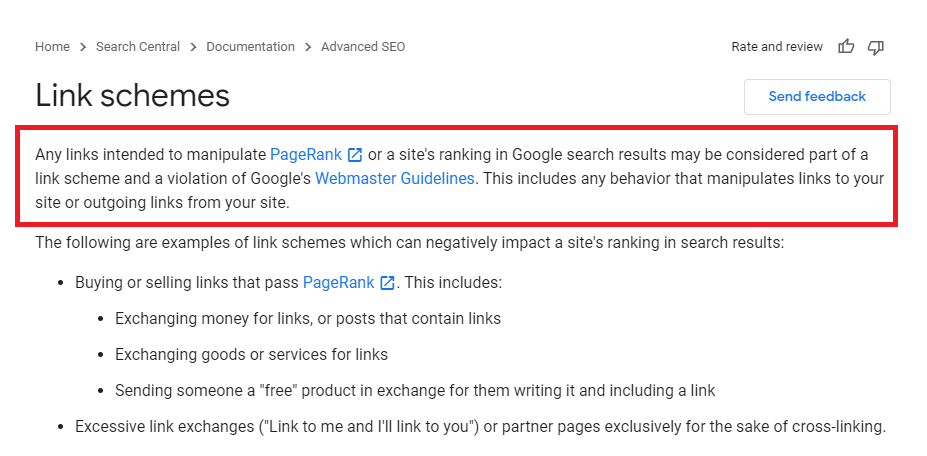
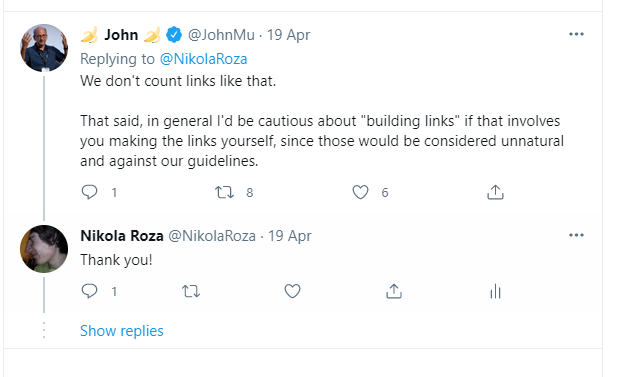
So any followed link that you influence in any way can be problematic, regardless of whether it points to your money page or not.
However, if a link is relevant there’s a good reason for the link to be there, if the webmaster approved it, the chances of getting hit are extremely low and you probably have nothing to worry about.
#2- Why Does Linking to Money Pages Work?
Linking to commercial content works and moves your rankings faster because the target page gets 100% of the equity passed through that link.
Whereas with techniques like the Skyscraper, all link juice first flows to page A and from there is tired when it reaches pages B, C, D…
This severely reduces the amount of link juice that gets passed to any page and the ranking effect is diluted.
#3- What Kind of Anchor Text Should I Use?
The name of the game is to look natural. So, not all your links should be keyword-rich, or worse be an exact match.
I like to borrow a link building concept from Nathan Gotch called “Anchor Text Cycling”
It goes like this…
Send an exact match anchor text as your first link. This is 100% safe because you can’t be penalized by one link. An exact-match anchor will move your page to the fastest.
Next, send unoptimized and semi-optimized links in this order.
- Branded anchor;
- Partial match anchor;
- Naked link anchor;
- Generic anchor;
- Branded anchor.
Track your results and if necessary, repeat the cycle.
The key to successful link building is to make it seem like links are coming in randomly, and anchor text cycling helps a lot.
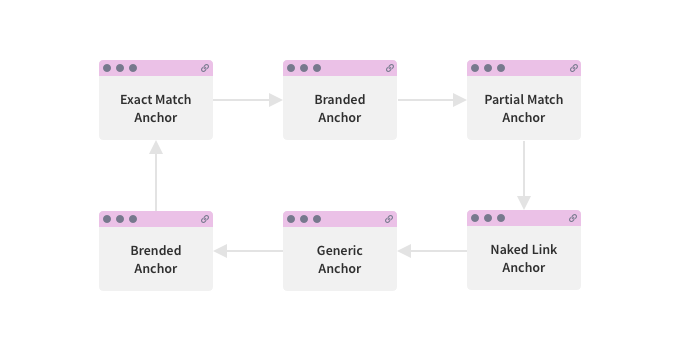
Pro tip: Divide your future referring domains in 2 buckets
Use your strongest anchor text with the strongest linking domains you have available. This will have the greatest impact on your rankings.
Use less impactful anchor text types on weaker sites.
#4- Should I Still Be Building Links to My Homepage? What About My Info Pages?
Always be building more links as your homepage is a natural target.
Most websites have the majority of their links pointing to their homepage.
There isn’t an exact science and definitely no exact percentage, but most sites have between 40% and 60% of all links pointing to their homepage.
Strive to emulate it and you’ll be fine.
You should also be building links to your info content. Not only is it completely natural to have links to your guides and how-to’s, but you can also use them for internal link building.
I know I said internal links don’t help nearly as much as backlinks, and it’s the truth, but they still help and can be an integral part of your SEO stratagem.
Pro tip: You probably have many money pages that you’d like to rank. But you most likely also have one or two that you’d do anything to rank highly in Google.
Am I right?
Take those two and link to them directly from your homepage.
This will pass huge authority as your homepage is probably the most authoritative page on your domain.
For example, let’s say you have a thousand followed links pointing to your homepage.
And you have fifty links on your homepage. (Use this tool to count).
If you remove one of those current links and replace them with your money link, then the net effect will be that twenty link’s PageRank will start flowing to your money page.
And the ranking effect will be very noticeable, especially if you link with a keyword-rich anchor text as well.
How about two examples, one good, one not so good?
If you go to my homepage and take a look, you’ll notice I link from my menu to my Unbounce coupon code page.
You can see the keyword rich anchor, and you can see I even added in the link title attribute for some additional relevance points.
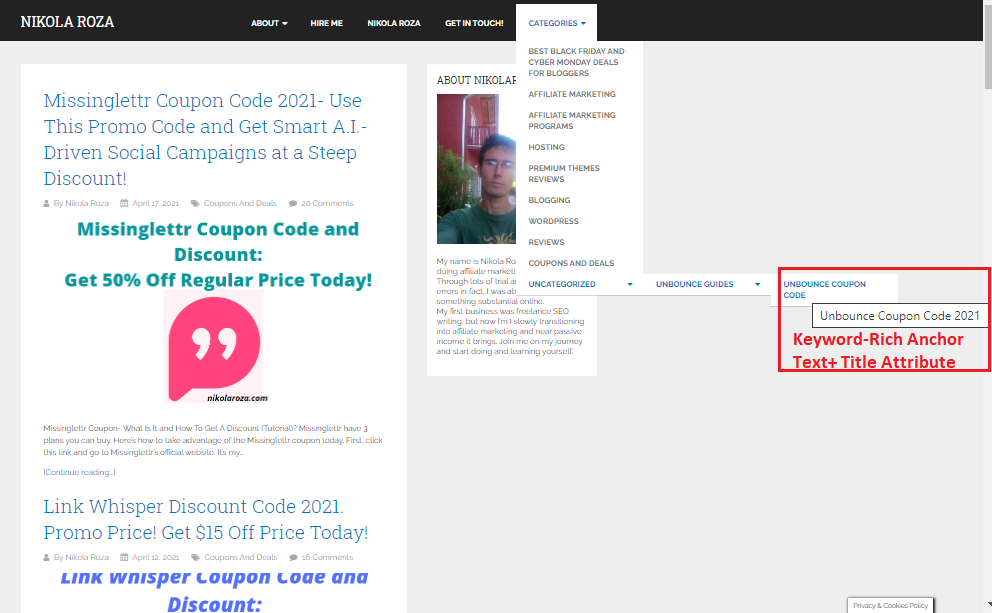
According to Ahrefs my homepage has 2.14k with 461 referring domains

Some of those links are nofollow, but for the sake of an example let’s pretend they’re 100% followed.
And my homepage plays a good host to 113 internal links.

So, 2140 links divide by 113 = 18.93 (19 links).
So, I can guess that at least 19 links worth of authority flows to my Unbounce coupon code page.
However, not all links are weighed equally.
The Reasonable Surfer model predicts that more PageRank will flow through links most likely to be clicked.
So I can safely assume my menu links flow more PageRank than the simple math suggests, simply because they’re so high up in HTML and they get clicked constantly.
Real quick before we wrap this post up, I mentioned you need to use keywords in your homepage internal link to get the maximum ranking benefit.
Here, my friend Lisa Sicard links to her AgoraPulse review, but instead of using “AgoraPulse review” as anchor, she uses “Why AgoraPulse for Social Media” which is a phrase that has zero search volume.

This is especially problematic because internal links so high up effectively cancel all internal anchor text diversity.
The first anchor text rule says that out of two (or many) anchors located on the same page, Google-bot counts only the first one and ignores the rest.
Conclusion
Here’s the simple truth:
If you want to rank a blog post on the first page of Google, and you have some competition, you’ll need to build links to it.
And I’m not talking about internal link building (though internal links have their place as well).
I’m talking about external links, backlinks that will pass maximum link juice to your page and help it rank higher.
There is no other way to rank for competitive queries, especially if you notice your competitors have built links in the past and are still building them in the present.
How will you keep up with just on-page SEO and social promotion?
I think it’s impossible, but I’m curious to hear your say.
Thank you!
- About the Author...






2 Responses
Thank you for publishing my article.
I’m honored to be able to share my knowledge with your audience.
I hope this guide helps someone rank for those lucrative money terms.
Hey Nikola, thanks so much for contributing a great article. I know our audience will love it!